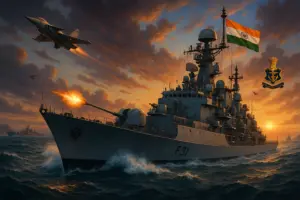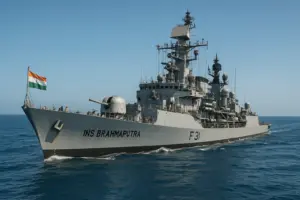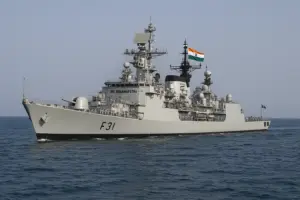Introduction
INS Brahmaputra (F31) is the lead ship of the Brahmaputra-class guided missile frigates of the Indian Navy. Commissioned on 14 April 2000, she was constructed at Garden Reach Shipbuilders and Engineers (GRSE) in Kolkata. The ship is named after the Brahmaputra River, symbolizing strength and resilience. Designed for multi-role operations, INS Brahmaputra has been a cornerstone of India’s naval capabilities.
Table of Contents
ToggleDesign and Construction
INS Brahmaputra’s design is an evolution of the Godavari-class frigates, incorporating modern technologies and indigenous systems. The Directorate of Naval Design proposed the basic design, with detailed development undertaken by GRSE. The construction faced delays due to design changes, labor issues, and integration challenges with the Trishul SAM. Laid down in 1989, the ship was finally commissioned in April 2000 after 11 years.
Design and Construction Table
| Feature | Specification |
|---|---|
| Length | 126.5 meters |
| Beam | 14.5 meters |
| Draft | 4.5 meters |
| Displacement | 3,850 tons |
| Crew Complement | 313 (259 enlisted, 40 officers, 14 aircrew) |
| Builder | Garden Reach Shipbuilders and Engineers |
| Commissioned | 14 April 2000 |

⚙️ Technical Specifications
INS Brahmaputra (F31) is a multi-role guided missile frigate, built to perform a variety of tasks ranging from anti-submarine warfare (ASW) to air defense and surface strike missions. She is equipped with an array of indigenous and imported systems, which provide her the ability to operate independently or as part of a task force.
The ship was designed by the Indian Navy’s Directorate of Naval Design and built by Garden Reach Shipbuilders and Engineers (GRSE), Kolkata. Its architecture builds upon the Godavari-class frigate but incorporates newer technologies and improvements across all key systems.
Key Highlights:
-
Capable of operating in blue water (open ocean) missions
-
Equipped with integrated combat management systems
-
Supports multi-role helicopters for ASW and SAR missions
-
Built with modular electronics architecture for ease of upgrades
-
Stealth-optimized design elements like low radar cross-section superstructure
Read More : Voronezh Radar
📊 Technical Specifications Table
| Category | Specification |
|---|---|
| Class & Type | Brahmaputra-class Guided Missile Frigate |
| Displacement | Approx. 3,850 tons (full load) |
| Length | 126.5 meters |
| Beam (Width) | 14.5 meters |
| Draft | 4.5 meters |
| Hull Design | Semi-stealth hull with RCS reduction features |
| Crew Complement | 313 (including ~40 officers and 14 aircrew) |
| Propulsion Type | Steam turbine propulsion system |
| Engines | 2 x BHEL steam turbines |
| Total Power Output | 30,000 shaft horsepower (shp) |
| Maximum Speed | 30 knots (approx. 55 km/h) |
| Range | 4,500 nautical miles at 12 knots cruising speed |
| Endurance | Up to 30 days at sea without replenishment |
| Radar Systems | RAWL-02 (Air Search), DA-08 (Surveillance), ZW-06 (Navigation), BEL Aparna (FCR) |
| Sonar Systems | HUMSA (Hull Mounted), Thales Towed Array sonar |
| Electronic Warfare | Indigenous ESM suite, jammers, decoy launchers |
| Combat Management | EMCCA – Electronic Modular Command and Control Applications (BEL-developed) |
| Navigation Systems | Decca Bridgemaster radar, GPS-integrated INS |
| Communication Systems | UHF/VHF radios, Inmarsat SATCOM, secure Indian Navy data-link |
| Aviation Facilities | Enclosed hangar and flight deck for 2 helicopters (Sea King or Chetak/MATCH) |
| Mission Role | Anti-Air, Anti-Surface, Anti-Submarine, Maritime Security, Search & Rescue (SAR) |
Armament and Sensors
INS Brahmaputra is armed with a diverse array of weaponry and sensors, providing versatility in combat scenarios.
Armament and Sensors Table
| Weapon/System | Specification |
|---|---|
| Anti-Ship Missiles | 16 x 3M-24E (Kh-35 Uran) missiles in 4 quadruple KT-184 launchers |
| Main Gun | 1 x OTO Melara Super Rapid 76mm gun |
| Close-In Weapon System | 4 x AK-630 30mm Gatling guns |
| Torpedo Tubes | 6 x 324mm ILAS 3 torpedo tubes with Whitehead A244S torpedoes |
| Air Defence System | Initially Igla-M SAM, later retrofitted with Israeli Barak SAM |
| Fire Control Radar | BEL Aparna radar for anti-ship missiles |
| Combat Data System | BEL EMCCA system for integrated warfare management |
Propulsion System
INS Brahmaputra’s propulsion system ensures high-speed maneuverability and endurance. The ship is powered by steam turbines, providing the necessary thrust for various naval operations.
Propulsion System Table
| Component | Specification |
|---|---|
| Propulsion Type | Steam turbine |
| Manufacturer | Bharat Heavy Electricals Limited (BHEL) |
| Power Output | 15,000 bhp |
| Maximum Speed | 30 knots |
Aircraft and Hangar
INS Brahmaputra operates helicopters for anti-submarine warfare and surveillance. The ship’s hangar accommodates these aircraft, enhancing its operational capabilities.
Aircraft and Hangar Table
| Aircraft Type | Role |
|---|---|
| Westland Sea King | Anti-submarine warfare, search and rescue |
| MATCH (Chetak variant) | Anti-submarine warfare |
Operational History
INS Brahmaputra has participated in numerous naval exercises and humanitarian missions, showcasing its versatility and readiness.
Operational History Table
| Year | Operation/Event |
|---|---|
| 2000 | Commissioned into the Indian Navy |
| 2005 | Participated in multinational naval exercises |
| 2010 | Conducted humanitarian mission during natural disaster |
| 2015 | Engaged in joint exercises with foreign navies |
Read More : pinaka missile
Strategic Importance
INS Brahmaputra plays a crucial role in India’s maritime strategy, enhancing the Navy’s presence in the Indian Ocean region. Its capabilities contribute to regional security and power projection.
Comparison with Other Frigates
When compared to other frigates, INS Brahmaputra stands out in terms of indigenous systems and multi-role capabilities.
Comparison Table
| Feature | INS Brahmaputra | INS Shivalik (Project 17) | INS Talwar (Project 17A) |
|---|---|---|---|
| Combat Data System | BEL EMCCA | BEL CMS | BEL CMS |
| Air Defence System | Barak SAM | Barak 8 | Barak 8 |
| Propulsion Type | Steam turbine | CODAD (diesel) | CODAD (diesel) |
| Helicopter Capacity | 2 | 2 | 2 |
🛠️ Future and Modernization
INS Brahmaputra, being over two decades old, is reaching a point in its service life where modernization is essential to maintain operational relevance. While the ship was cutting-edge at the time of commissioning in 2000, advances in naval warfare technology, electronic systems, propulsion, and combat systems necessitate significant upgrades.
The Indian Navy has initiated a comprehensive mid-life upgrade (MLU) program aimed at:
-
Extending the operational life of the ship by 10–15 years
-
Enhancing survivability in modern conflict zones
-
Integrating with network-centric warfare systems
-
Improving energy efficiency and performance
-
Upgrading weapons systems to counter current and emerging threats
This modernization is intended not just as a technological overhaul, but also to ensure interoperability with next-generation platforms like the Project 17A frigates, aircraft carriers, and unmanned systems.
🔧 Modernization Plans Table
| Upgrade Area | Planned Enhancements |
|---|---|
| Propulsion System | Overhaul of steam turbines for higher efficiency; integration of digital engine control systems; noise-reduction measures to support stealthier operations. |
| Combat Management System (CMS) | Replacement of BEL EMCCA with a newer generation indigenous CMS capable of real-time data fusion, automated threat response, and integration with multi-platform sensors. |
| Weapons Systems | Upgrade from older Kh-35 Uran missiles to BrahMos-NG or other modern anti-ship missiles; integration of Vertical Launch System (VLS) for long-range SAMs. |
| Air Defence | Replacement of Igla-Barak combo with Barak-8 or newer Quick Reaction SAM systems; improved radar-guided target acquisition. |
| Sonar and ASW | Replacement of BEL HUMSA sonar with newer variants like HUMSA-NG; integration with advanced towed array sonar for deep-sea submarine detection. |
| Electronic Warfare | Advanced electronic support measures (ESM), jamming capability, decoy launchers, and secure datalinks for electronic warfare readiness. |
| Radar and Sensors | Installation of modern 3D air/surface search radars like RAWL-03 NG; improved target tracking; dual-band surveillance radars. |
| Communication Systems | Upgrade to satellite-enabled secure communication; integration with Navy’s NCO (Network-Centric Operations) grid for fleet-wide data sharing. |
| Structural Upgrades | Reinforcement of superstructure and hull for better survivability; application of radar-absorbing materials for reduced RCS (Radar Cross Section). |
| Aviation Facilities | Hangar and deck refit to support newer rotorcraft (e.g., MH-60R or ALH-Navy); integration of UAV launch and recovery capabilities. |
🛡️ Goals of the Modernization Program:
-
Sustain combat-readiness in a contested Indo-Pacific environment
-
Improve shipboard automation to reduce crew fatigue and response time
-
Enhance interoperability with allies and multi-national forces
-
Ensure compliance with emerging cybersecurity and electronic warfare standards
Future and Modernization
Modernization Plans Table
| Upgrade Area | Planned Enhancements |
|---|---|
| Propulsion System | Overhaul and efficiency improvements |
| Combat Systems | Upgrade to next-gen fire control and combat management systems |
| Air Defence | Integration of advanced Barak-8 or equivalent missile systems |
| Communication Systems | Integration of satellite and secure data links |
| Electronic Warfare | Enhanced jamming and electronic countermeasures |
| Sensors & Surveillance | Installation of modern sonar and radar systems |
INS Brahmaputra Fire
In August 2023, a minor fire broke out aboard INS Brahmaputra while it was docked at the Naval Dockyard in Mumbai. The fire reportedly began in one of the auxiliary compartments due to an electrical short circuit. The crew onboard acted swiftly, implementing the ship’s damage control procedures and bringing the situation under control before significant damage occurred.
There were no casualties reported, and the fire was extinguished in less than an hour. Naval authorities conducted a thorough investigation to identify and mitigate future risks.
INS Brahmaputra News
INS Brahmaputra frequently appears in naval and defence-related news due to its long operational history, involvement in international maritime exercises, and recent incidents like the 2023 fire. It remains a high-profile frigate due to its status as the lead ship of its class and its visibility in multilateral missions like the MILAN series of naval exercises and anti-piracy patrols in the Gulf of Aden.
INS Brahmaputra Fire
The August 2023 fire aboard the frigate drew attention not only because of its implications for fleet safety but also due to the vessel’s age and modernization needs. Experts noted that older ships like Brahmaputra, though reliable, require regular upgrades to critical systems such as electrical wiring, fire suppression, and auxiliary power units. The fire highlighted the importance of timely maintenance and refit schedules to avoid operational downtime or risks to personnel.
INS Brahmaputra Restoration
Following the fire incident, INS Brahmaputra was placed under a temporary maintenance and inspection phase. The restoration process involved:
-
Structural assessment of affected compartments
-
Replacement of damaged cables and electrical systems
-
Overhaul of the auxiliary systems that were impacted
-
Re-certification of fire and damage control systems
-
Partial modernization of onboard electronic systems
The Indian Navy confirmed the ship returned to operational status within two months, demonstrating robust logistical support and maintenance protocols.
INS Brahmaputra Accident
Apart from the 2023 fire, INS Brahmaputra has maintained an excellent safety record over its two-decade-long service. There are no major recorded collisions or operational mishaps involving loss of life or significant material damage. This consistent record reflects the professional seamanship of her crew and the robustness of the ship’s design.
INS Brahmaputra Cost
The Brahmaputra-class frigates, including INS Brahmaputra, were developed as a cost-effective indigenous alternative to foreign-built warships. The cost was managed through local construction and system integration.
Cost Table
| Component | Estimated Cost (INR) | Remarks |
|---|---|---|
| Shipbuilding | ₹750 crore | GRSE-built in India |
| Weapons & Systems | ₹350 crore | Includes missiles, sonar, radars |
| Total Project Cost | ₹1,100 crore (approx.) | Equivalent to ~$140 million USD |
INS Brahmaputra Class
The Brahmaputra-class is a group of three guided missile frigates:
-
INS Brahmaputra (F31)
-
INS Betwa (F39)
-
INS Beas (F37)
These ships are successors to the Godavari-class and share similar hull forms but with upgraded weapons and systems.
Brahmaputra-Class Table
| Ship Name | Pennant No. | Commissioned | Status |
|---|---|---|---|
| INS Brahmaputra | F31 | April 2000 | Active |
| INS Betwa | F39 | July 2004 | Active |
| INS Beas | F37 | July 2005 | Active |

INS Brahmaputra Commanding Officer
The commanding officer (CO) of a ship like INS Brahmaputra is a senior Indian Navy officer, usually of the rank Captain. As of the last update in 2024, Captain Amit Sharma was the commanding officer of INS Brahmaputra. The CO is responsible for the overall safety, operations, and performance of the ship and its crew.
Commanding Officer Table
| Name | Rank | Service Period | Notable Achievements |
|---|---|---|---|
| Captain Amit Sharma | Captain | 2023 – Present | Led post-fire restoration; MILAN 2024 participant |
Conclusion
INS Brahmaputra remains a vital asset to the Indian Navy. Despite her age, the ship has shown resilience and adaptability, demonstrated in her successful restoration after the 2023 fire, continued participation in key maritime missions, and ongoing modernization efforts.
With India’s strategic interest growing in the Indo-Pacific region, ships like INS Brahmaputra will continue to play a key role in ensuring maritime security, freedom of navigation, and showcasing India’s indigenous shipbuilding capabilities.
Key Facts at a Glance
| Attribute | Details |
|---|---|
| Name | INS Brahmaputra |
| Namesake | River Brahmaputra |
| Builder | Garden Reach Shipbuilders and Engineers |
| Launched | 29 January 1994 |
| Commissioned | 14 April 2000 |
| Identification | F31 |
| Nickname(s) | The Raging Rhino |
| Status | Temporarily inactive, sustained severe damage in major fire |
General Characteristics
| Attribute | Details |
|---|---|
| Class and type | Brahmaputra-class guided missile frigate |
| Displacement | 3,850 tons |
| Length | 126.4 m (414 ft 8 in) |
| Beam | 14.5 m (47 ft 7 in) |
| Propulsion | 2 steam turbines, 22,370 kW (30,000 shp), 2 shafts |
| Speed | 30 knots (56 km/h; 35 mph)+ |
| Range | 4,500 nautical miles (8,300 km; 5,200 mi) |
| Complement | 440 to 450 (including 40 officers + 13 aircrew) |
Sensors and Processing Systems
| Type | Details |
|---|---|
| Radar | BEL RAWS-03 air/surface search radar BEL/Signaal RAWL-02 (PLN 517) air search radar Decca Bridgemaster/BEL Rashmi PIN 524 navigation radar |
| Sonar | BEL HUMSA (Hull Mounted Sonar Array) Thales Sintra towed array sonar |
| Fire Control | BEL Aparna radar (Kh-35 SSM) Elta EL/M-2221 radar (Barak SAM) BEL Shikari opto-electronic trackers (guns) |
| Electronic Warfare & Decoys | BEL Ajanta Mk.2C Electronic Warfare system ELLORA Electronic Support Measures system BEL Radar Warning Receiver Suite 2 × chaff/flare launcher Super Barricade chaff launcher 2 × Graesby G738 or BEL TOTED towed torpedo decoy |
Armament
| Type | Details |
|---|---|
| Surface-to-Surface Missiles | 16 × Kh-35 (SS-N-25) SSM (4 x quadruple KT-184 launchers) |
| Surface-to-Air Missiles | 24 × Barak SAM (3 x octuple VLS units) |
| Guns | 1 × OTO Melara 76 mm gun 4 × AK-630 30 mm gatling guns |
| Anti-Submarine Weapons | 2 × RBU-6000 rocket launchers 2 × triple ILAS 3 324 mm torpedo tubes (Whitehead A244S torpedoes) |
Aircraft
| Attribute | Details |
|---|---|
| Aircraft Carried | 1 × Sea King |
Read More : dornier 228
Faq’s
1. What is INS Brahmaputra and what type of ship is it?
Answer:
INS Brahmaputra (F31) is a guided missile frigate of the Indian Navy. It belongs to the Brahmaputra-class frigates, which are indigenously designed and built in India. These ships are multi-role frigates capable of engaging surface, air, and underwater threats.
2. When was INS Brahmaputra commissioned into the Indian Navy?
Answer:
INS Brahmaputra was commissioned on 14 April 2000. It was built at Garden Reach Shipbuilders and Engineers (GRSE) in Kolkata, continuing India’s initiative to build modern warships indigenously.
3. What are the main features and armaments of INS Brahmaputra?
Answer:
INS Brahmaputra is equipped with:
-
Surface-to-surface missiles (SSMs) and surface-to-air missiles (SAMs)
-
Medium-range guns
-
Anti-submarine warfare (ASW) torpedoes and rocket launchers
-
Advanced radar and electronic warfare systems
It also carries a Sea King helicopter for extended reconnaissance and ASW operations.
4. What is the primary role or mission of INS Brahmaputra?
Answer:
The ship’s primary mission is multi-dimensional naval warfare, including:
-
Escort duties
-
Surveillance
-
Anti-submarine warfare
-
Surface and aerial combat
It plays a key role in safeguarding India’s maritime interests in the Indian Ocean Region (IOR).
5. Has INS Brahmaputra participated in any notable naval operations or missions?
Answer:
Yes, INS Brahmaputra has participated in several important missions, including:
-
Joint naval exercises with other countries (e.g., UK, France, USA)
-
Anti-piracy operations in the Gulf of Aden
-
Humanitarian missions and goodwill visits to promote naval diplomacy
Read Also – Operation Sindoor

